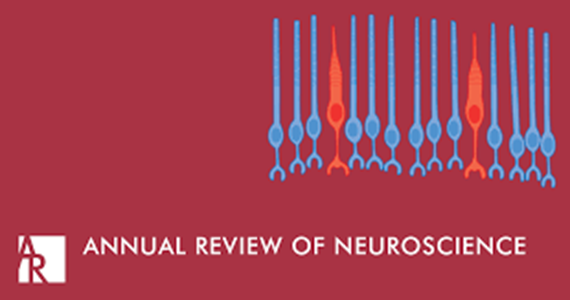The Visual Systems of Zebrafish.
IF 12.1
1区 医学
Q1 NEUROSCIENCES
引用次数: 0
Abstract
The zebrafish visual system has become a paradigmatic preparation for behavioral and systems neuroscience. Around 40 types of retinal ganglion cells (RGCs) serve as matched filters for stimulus features, including light, optic flow, prey, and objects on a collision course. RGCs distribute their signals via axon collaterals to 13 retinorecipient areas in forebrain and midbrain. The major visuomotor hub, the optic tectum, harbors nine RGC input layers that combine information on multiple features. The retinotopic map in the tectum is locally adapted to visual scene statistics and visual subfield-specific behavioral demands. Tectal projections to premotor centers are topographically organized according to behavioral commands. The known connectivity in more than 20 processing streams allows us to dissect the cellular basis of elementary perceptual and cognitive functions. Visually evoked responses, such as prey capture or loom avoidance, are controlled by dedicated multistation pathways that-at least in the larva-resemble labeled lines. This architecture serves the neuronal code's purpose of driving adaptive behavior.斑马鱼的视觉系统
斑马鱼视觉系统已成为行为和系统神经科学的典范。约有 40 种视网膜神经节细胞(RGC)充当刺激特征的匹配过滤器,包括光线、光流、猎物和碰撞中的物体。视网膜神经节细胞通过轴索将信号传递到前脑和中脑的 13 个视网膜感受区。视神经运动的主要枢纽--视神经束中有九个 RGC 输入层,它们结合了多种特征信息。视网膜构造中的视网膜定位图局部适应视觉场景统计和视觉子场特定的行为需求。视网膜投射到前运动中枢的拓扑结构是根据行为指令组织的。已知的 20 多个处理流的连接性使我们能够剖析基本感知和认知功能的细胞基础。视觉诱发的反应,如捕获猎物或躲避织布机,是由专用的多活化通路控制的,至少在幼虫时期,这些通路类似于标记线。这种结构可以实现神经元代码驱动适应行为的目的。
本文章由计算机程序翻译,如有差异,请以英文原文为准。
求助全文
约1分钟内获得全文
求助全文
来源期刊

Annual review of neuroscience
医学-神经科学
CiteScore
25.30
自引率
0.70%
发文量
29
期刊介绍:
The Annual Review of Neuroscience is a well-established and comprehensive journal in the field of neuroscience, with a rich history and a commitment to open access and scholarly communication. The journal has been in publication since 1978, providing a long-standing source of authoritative reviews in neuroscience.
The Annual Review of Neuroscience encompasses a wide range of topics within neuroscience, including but not limited to: Molecular and cellular neuroscience, Neurogenetics, Developmental neuroscience, Neural plasticity and repair, Systems neuroscience, Cognitive neuroscience, Behavioral neuroscience, Neurobiology of disease. Occasionally, the journal also features reviews on the history of neuroscience and ethical considerations within the field.
 求助内容:
求助内容: 应助结果提醒方式:
应助结果提醒方式:


